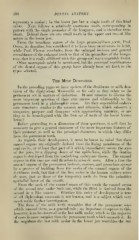Page 488 - My FlipBook
P. 488
498 DENTAL ANATOMY.
represents a canine ; in the lower jaw but a single tooth of this kind
exists. Next follows a relatively enormous tooth, corresponding in
pattern with the single premolar of the kangaroo, and is therefore tren-
chant. Behind these are one small tooth in the upper and two of like
nature in the lower jaw.
From the trenchant nature of the large premolariform .teeth, Prof.
Owen, its describer, has considered it to have been carnivorous in habit,
while Prof. Flower concludes, from the enlarged incisors and general
resemblance of the enlarged teeth to that of the premolars of the kanga-
roos, that it is really affiliated with this group and was a vegetal)le feeder.
Other marsupials might be mentioned, but the principal modifications
of the dental organs of this group have already been set forth in the
types selected.
The Milk Dentition.
In the preceding pages we have spoken of the deciduous or milk den-
tition of the diphyodont Mammalia so far only as they relate to the
permanent set in matters of definition. It now remains to discuss the
more important question of their true nature and relationship to the
permanent teeth in a philosophic sense. Are they superadded embry-
onic structures similar to the amnion and allantois, which subserve a
temporary purpose and disappear with approaching maturity, or are
thev to be homologized with the first set of teeth of the lower Verte-
brata ?
Before proceeding to a discussion of these questions, it will first be
necessarv to give a general statement of the more important features of
their anatomy, as well as the principal characters in which they differ
from the permanent teeth.
As regards their development, it nuist be borne in mind that their
enamel organs are originally derived from the lining membrane of the
oral cavity, or at least that jiart of it which immediately covers the axes
of the jaws, by a dipping down of the epithelium, while the dentine
organ is devcloi)ed from the underlying end^ryonic tissue. The enamel
organs in this case are said therefore to arise (h> novo. After a time the
enamel organs of the ]X'rmanent incisors, canines, and premolars appear
bv a process of budding from the necks of the enamel organs of the
deciduous teeth, but that of the first molar in the human subject arises
de novo, just as those of the temporary teeth do from the ])rimitive
epithelial layer of the mouth.
From the neck of the enamel organ of this tooth the enamel organ
of the second true molar buds out, Avhile the third is derived from the
second in a like maimer. Whether tliis order of development is true
of all di])hyodont mammals is not known, and is a subject which very
much needs further investigation.
The form of the milk teeth resembles that of the permanent ones
which succeed them, as a general rule ; an important exception to this,
however, is to be observed in the last milk molar, which in the majority
of cases is more complex than the permanent tooth which succeeds it. In
the ungulates the last milk molar in the lower jaw resembles the last


